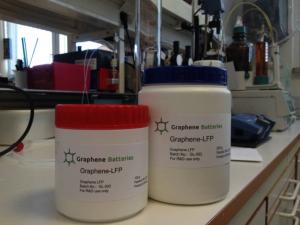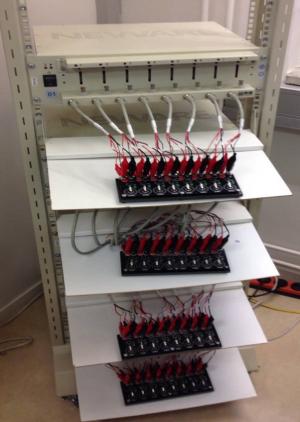Graphene Batteries is a Norwegian company that was founded over two years ago in order to explore the potential of graphene in batteries and develop practical graphene-based battery products.
Its vision is to provide robust battery materials for a renewable energy ecosystem, aiming to create durable battery materials that are reliable, safe and green.
 The sample, which is the proprietary LFP/graphene powder (cathode material for Li-ion batteries). It has about 20% higher capacity than the state of the art carbon coated LFP powder, an improvement that is even more significant at higher currents. Moreove
The sample, which is the proprietary LFP/graphene powder (cathode material for Li-ion batteries). It has about 20% higher capacity than the state of the art carbon coated LFP powder, an improvement that is even more significant at higher currents. Moreove
 A testing rig where cells are tested for energy and power density measurements, cycle life etc.
A testing rig where cells are tested for energy and power density measurements, cycle life etc.

Rahul Fotedar, Research Manager & Co-founder of Graphene Batteries, graciously agreed to answer Graphene-info’s questions and share his insights on Graphene Batteries’ work, as well as the graphene battery market in general.
Q. Hello Rahul, would you give us a brief review of Graphene Batteries’ current projects and activities?
Graphene Batteries is not in the business of making graphene, it is simply identifies and sources the most useful material for the particular electrochemical storage application for a specific application.
We are currently working on a few projects/technologies on all of which we are progressing nicely. The first work we started to do was to look at the potential of graphene to be a conductive additive in batteries. The results show that with a proper choice of material and processing method it can indeed not only replace but greatly reduce the carbon content in the battery.
The second technology we are working is on conversion cathode and anode materials which are sulfur and silicon respectively. Both these materials will be incorporated in the next generation of high energy lithium batteries and here again we see graphene playing an instrumental role in acting as a supporting matrix for enhancing the cycle life of the batteries.
Finally we have done some exciting work together with CVD Corporation USA on high loading electrodes using graphene and ultralong carbon nanotubes. There is a huge cost and performance premium on being able to build thick electrodes. We were able to make stable electrodes with a loading of up to 400 mg/cm2, which is more than 20 times the existing loading on state of art lithium-ion cells.
Q. Can you shed some light on where the company stands in terms of commercialization readiness?
From a technology development perspective we are still in the middle of the development process but are hoping to come out with some game changing products. At the same time we are actively seeking partnerships with larger companies who have the insight and manpower to take our technology and integrate it in a final product.
Q. There seems to be a lot of buzz around graphene batteries and the revolution it’ll bring. how do you feel about all that?
There has been a tremendous hype about what Graphene can do for electrochemical storage and I think this hype has been both good and bad for us. Good, because it drew attention towards us and bad, because lot of what is talked about would simply not be possible when we will set out to make a practical product. Graphene as we know it now is such a family of materials from GO (produced by so many means), rGO (reduction done by a myriad number of means) and not to mention graphene directly produced by other methods like CVD, shearing, plasma etc. This, topped with the fact that existing manufacturers of any kind of carbon materials have also started to label themselves as graphene producers. All of these materials have completely different properties and potential uses and one of the popular questions going around is what exactly is Graphene.
Q. What about the common view that graphene batteries can have up to 4X capacity than traditional ones?
Unless graphene manages to be a key enabling factor for next generation Li/Sulfur or Li/air batteries, 2X or 4X capacity doesn't seem possible. I haven't yet seen even a graphene based prototype cell with at least 1-2 Ah of capacity (size of a phone battery) which is four times less in weight or volume than what we got now. The real key in storage is to move from coin cell (mAh) to real cells (Ah) and get the same results, this fact seems to be totally neglected in the reported literature.
Q. This is very interesting. So you’re saying that a lot of the hype is exaggerated? Graphene might not revolutionize the battery market to the extent that is talked about?
3x or 4x the capacity capability based on silicon/graphene is simply false.
A 20% improvement in final energy density is much more realistic. However, if graphene enables the commercialization of Li/sulphur or Li/air batteries, then it may really change things but for now there is no real battery out there to validate this claim.
Q. So how do you see graphene’s impact on the battery market in the near future? Do you have any projections as to when we can expect commercial graphene batteries?
I believe graphene has a definitive role to play in high power batteries which is vital for fast charging times. However building practical batteries with both high energy and power density still remains elusive.
The first generation of graphene enhanced batteries which would have measurable and practical improvement of about 30% better than state of art should reach the consumers in the next 3 years.



